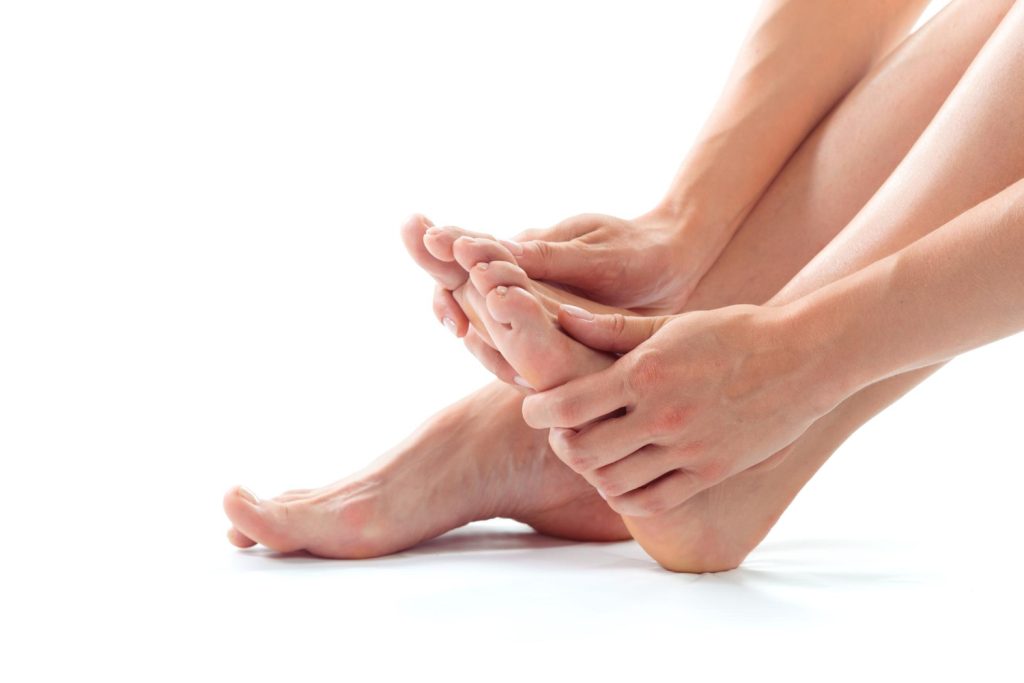Why Are The Bottoms Of My Feet Yellow? Understanding The Causes & Management

- Feet
- 12 Oct 2023
Introduction
Yellow Feet
Yellow feet can be a cause for concern and a sign that something might be amiss with your health. While most people associate yellowing of the skin with jaundice, yellowing discoloration in the field is a lesser-known but equally significant symptom that can indicate various underlying medical conditions or lifestyle factors. We will explore the causes, symptoms, diagnosis, and available treatments for yellow foot in this extensive health article. Whether you have recently noticed this unusual change in the color of your feet, or are simply curious about the potential health implications, this article aims to provide you with valuable insights and guidance on understanding and addressing the phenomenon of yellow feet.

Yellow Feet
What are Yellow Feet?
- It is a condition characterized by the abnormal yellow discoloration of the skin on the soles of the feet can be perplexing and worry about some occurrence.
- While it is less common than the more widely recognized yellowing of the skin or jaundice, no less significant in its potential implications for your health.
- It is also known as plantar erythema, which occurs when a noticeable yellow tends to the skin on the souls of the feet.
- This discoloration can vary in intensity, ranging from a pale-yellow hue to a deeper, more pronounced yellow or orange coloration. 1 Yellow Feet | Researched based study from National Institutes of Health
Causes

Causes of Yellow Feet
Medical conditions:
- Liver disorders
- Hemolysis
- Kidney dysfunction
- Thyroid disorders
- Lifestyle factors
- Dietary choices
- Smoking and toxins
- Environmental factors
- Exposure to heavy metals
- Allergies or irritants
There are many causes of yellow feet, including illnesses, lifestyle decisions, and environmental factors. Understanding these is essential for determining the appropriate course of action and treatment.
Liver disorders
Liver diseases such as hepatitis, cirrhosis, obstructive jaundice can disrupt the routine processing of bilirubin, leading to its accumulation in the skin, including the feet.
Hepatitis
- Hepatitis is a liver inflammation frequently brought on by viral infections. In cases of hepatitis, the liver’s ability to process bilirubin is compromised, leading to its build-up in the bloodstream and subsequent yellowing of the skin.
Cirrhosis
- It is a stage of advanced liver scarring brought on by a variety of liver ailments and illnesses. As it progresses, liver function deteriorates, affecting bilirubin metabolism.
Obstructive jaundice
- This syndrome develops when the bile ducts get blocked, preventing the movement of bile from the liver to the intestine. As a result, bilirubin cannot be adequately excreted, leading to its accumulation in the body and visible yellowing of the skin.
Hemolysis
- Conditions that cause an accelerated breakdown of red blood cells, like hemolytic anemia, can result in increased bilirubin production and, subsequently, yellowing of the skin, including the feet.
- A set of illnesses known as hemolytic anemia are distinguished by the early breakdown of red blood cells. When red blood cells break down rapidly, more bilirubin is produced, overwhelming the liver’s capacity to process it. This excess bilirubin can cause skin and eyes to turn yellow, including the skin on the feet.
Kidney dysfunction
- Impaired kidney function can affect the excretion of waste products from the body, including bilirubin, contributing to the yellowing of the skin.
Thyroid disorders
- Thyroid-related conditions such as hypothyroidism can impact overall metabolism, potentially causing changes in skin pigmentation.
- When the thyroid gland does not produce enough thyroid hormones, hypothyroidism develops.
- The metabolism is regulated by thyroid hormones, and their absence can have an impact on a number of body processes, including skin pigmentation. Skin changes, including yellowing, can be associated with thyroid disorders. 2 Causes| Researched based study from National Institutes of Health,3 Causes| Researched based study from National Institutes of Health,4 Causes| Researched based study from National Institutes of Health,5 Causes| Researched based study from National Institutes of Health
Lifestyle Factors
Dietary choices
- Poor dietary habits, including excessive consumption of foods high in carotenoids (for example, carrots and sweet potatoes) can lead to carotenoderma a condition characterized by yellowing of the skin.
Smoking and toxins
- Smoking and exposure to certain toxins or chemicals can affect the skin health and contribute to skin discoloration.
Environmental factors
- Exposure to heavy metals Occupational exposure to heavy metals like cadmium or lead can lead to skin discoloration.
Allergies or irritants
- Contact dermatitis is caused by exposure to allergens or returns in the environment can result in localized skin changes, potentially affecting the feet. 2 Causes| Researched based study from National Institutes of Health,3 Causes| Researched based study from National Institutes of Health
Symptoms
Symptoms of Yellow Feet
- Yellowing
- Itching
- Weakness
- Abdominal discomfort
- Dark urine
- Pale stools
- Other symptoms of underlying condition (if any).
The primary symptom is the abnormal yellow discoloration of the skin. This can vary in intensity, ranging from a pale yellow pronounce yellow or even orange coloration.
In addition to that, people may also experience the following signs:
Yellowing of other skin areas
- Yellowing of the foot’s skin is frequently accompanied by elsewhere on the body, such as the eyes, face, or hands.
Itching or pruritus
- Some people may experience itching or pruritus, which can be a result of skin irritation due to the build-up of bilirubin.
Fatigue
- If an underlying liver or kidney condition causes it people may experience fatigue, weakness, and overall Malaise
- In cases where liver or gallbladder issues contribute to yellow feet, people may also experience abdominal pain, especially in the upper right side of the abdomen.
Dark urine
- In conditions like hepatitis or liver dysfunction, urine can become dark or tea-colored due to excess bilirubin.
Pale stools
- Problems can lead to pale-colored stools due to a lack of bilirubin reaching the intestines.
Other symptoms of an underlying condition.
- Depending on the underlying cause, individuals with yellow feet may experience additional symptoms related to the associated medical condition. For example, people with hepatitis may experience nausea, jaundice, and abdominal discomfort. 1 Symptoms| Researched based study from National Institutes of Health
Diagnosis
Diagnosis of Yellow Feet
In most cases, a healthcare practitioner must perform a thorough evaluation before determining the reason of yellow feet. The process may include several steps and medical tests to identify the underlying condition responsible for the discoloration. Here is an overview:
Medical history
- A thorough medical history will be obtained by the healthcare professional first. They will enquire about your symptoms when you first noticed the yellowing, any associated medical conditions, medication history, and lifestyle factors that might be relevant.
Physical examination
- Physical examination will be conducted focusing on the skin, eyes, abdomen, and extremities.
Blood tests
- There is a crucial part of the diagnostic process, common ones include:
Liver function test
- These considerable amounts of bilirubin, liver enzymes, and other indicators can be used to evaluate the health and function of the liver.
Complete blood count
- It can help identify abnormalities and red and white blood cell counts, which may be indicative of conditions like anemia or hemolysis.
Thyroid function test
- If thyroid disorders are suspected, a test measuring thyroid hormone levels may be conducted.
Kidney function test
- Kidney function can be evaluated through tests like serum creatinine and glomerular filtration rate assessment. 6 Diagnosis| Researched based study from National Institutes of Health
Imaging studies
- Imaging studies may occasionally be required to view the liver, gallbladder, or bile ducts. Ultrasound, CT scans, or MRI can provide detailed images of these organs.
Biopsy
- A liver biopsy may be advised if liver disease is suspected. This will make it easier to identify the precise ailment present and the degree of liver damage.
Additional test
- Depending on the findings from the initial tests and physical examination, additional tests may be required to rule out specific medical conditions or pinpoint the underlying cause.
- These may include serological test for infectious diseases such as hepatitis, autoimmune markers, and genetic testing in some instances. 6 Diagnosis| Researched based study from National Institutes of Health
Management
How to Get Rid of Yellow Bottom Feet?
Medical Treatments:
Treatment of underlying medical conditions
The primary approach is to treat medical conditions responsible for the discoloration, this may involve:
Liver disease management
- If liver disorders like hepatitis or cirrhosis are the cause, treatment aims to manage the liver condition, which may include medications,
- Lifestyle modifications in severe cases of liver transplantation.
Hemolysis management
- Hemolytic anemia requires management to reduce the accelerated breakdown of red blood cells. Treatment may involve medications, blood transfusions, or addressing the underlying cause.
Kidney disease management
- For kidney-related causes, treatment focuses on managing kidney dysfunction through medications, dietary changes, and lifestyle modifications.
Thyroid disorder treatment
- With the use of thyroid hormone replacement therapy, conditions like hypothyroidism can frequently be controlled.
Symptom relief
- If pruritus (itching) is a symptom, medications or topical treatments may be prescribed.
Bile duct obstruction intervention
- In cases of obstructive jaundice due to bile duct blockage, procedures like endoscopic retrograde cholangiopancreatography (ERCP) or surgery may be necessary to remove the obstruction. 7 Management| Researched based study from National Institutes of Health
Lifestyle Changes:
Alcohol and toxin avoidance
- If alcohol consumption or exposure to toxins is contributing to liver damage and yellowing of the feet, it is essential to reduce or eliminate these factors from your lifestyle.
Smoking cessation
- Quitting smoking can benefit overall skin health and may help reduce skin discoloration.
Dietary Recommendations:
Balanced diet
- Consuming a diet that is well-balanced and abundant in fruits, vegetables, and whole grains can enhance general health and possibly aid in the management of specific illnesses.
Specialized diet
Dietary modifications may sometimes be recommended based on the specific underlying condition. For example:
- Individuals with liver disease may need to limit sodium intake and avoid specific high-protein diets.
- Hemolytic anemia patients may require a diet rich in iron or vitamin B12.
- Individuals with thyroid disorders may benefit from iodine-rich or iodine avoids and diets depending on the specific condition. 8 Management| Researched based study from National Institutes of Health
FAQs
Frequently Asked Questions About Yellow Feet
Q. Do yellow feet mean diabetes?
- Yellow feet alone are not a direct symptom or indicator of diabetes. However, diabetes can lead to various skin complications, including the feet.
Q. Do yellow feet mean liver failure?
- It can be a sign of liver dysfunction or liver disease, but they do not necessarily indicate liver failure on their own.
Q. Is it normal for feet to be a little yellow?
- It’s not considered normal for feet to be yellowish. Skin color can occur. Obviously abnormal, yellow skin tendencies should be assessed by a healthcare practitioner.
Q. What color should the bottom of the feet be?
- The standard color is typically a shade that matches the rest of your skin, which is often a light to medium tan or brown, depending on the skin type and exposure to sunlight.
Any feedback on this article?
 This Articles content was accurate
This Articles content was accurate Very Informative Article
Very Informative Article I have a question or a comment
I have a question or a comment
 This article contains inaccurate content
This article contains inaccurate content This article was not helpful
This article was not helpful I have a question or a comment
I have a question or a comment
We appreciate your helpful feedback!
Checkout our social pages
References
-
National Institutes of Health
Yellow Feet | Symptoms
-
National Institutes of Health
Causes
-
National Institutes of Health
Causes
-
National Institutes of Health
Causes
-
National Institutes of Health
Causes
-
National Institutes of Health
Diagnosis
-
National Institutes of Health
Management
-
National Institutes of Health
Management






































